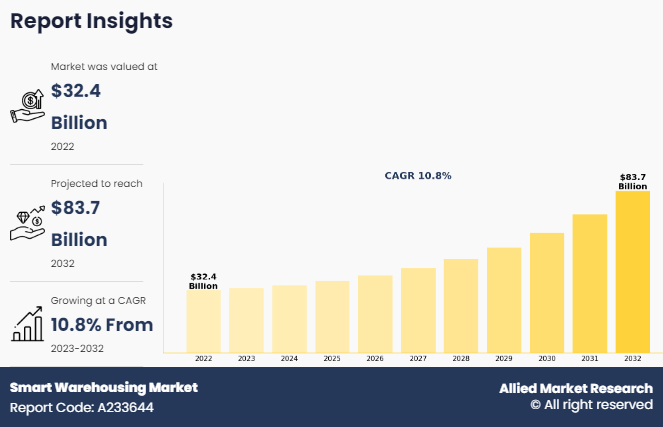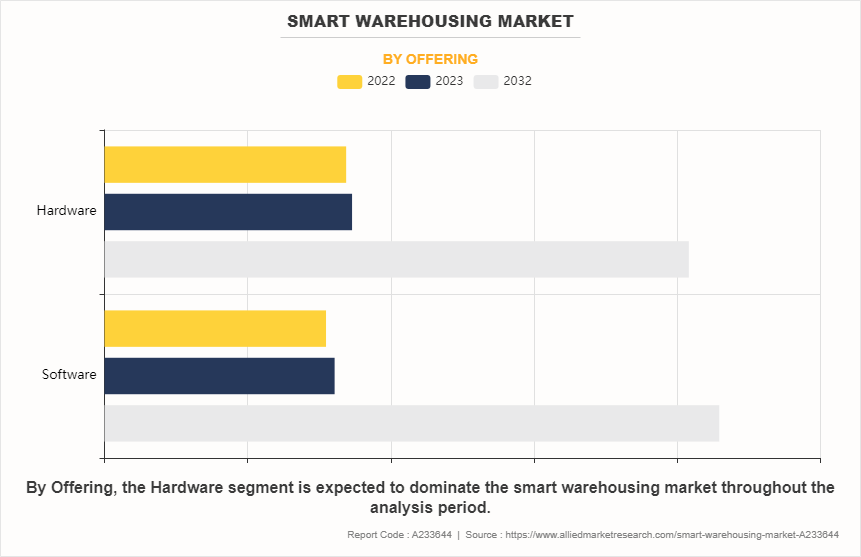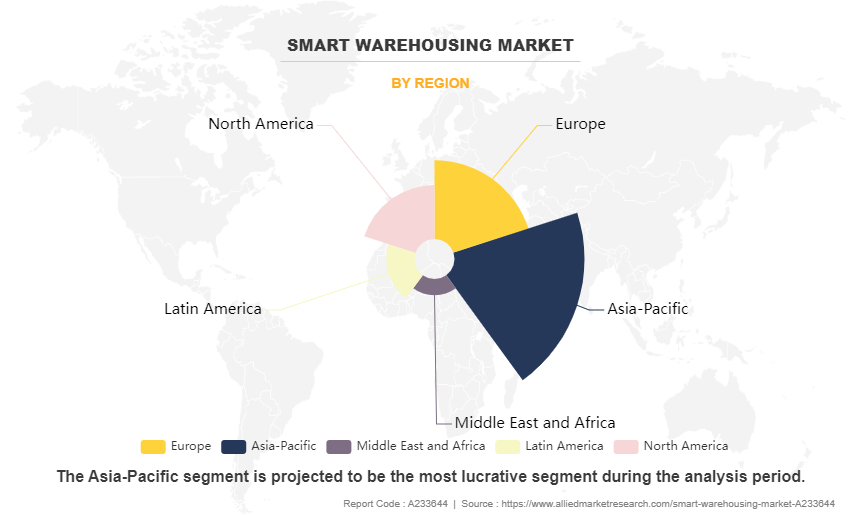Smart Warehousing Market Overview
The global smart warehousing market size was valued at USD 32.34 billion in 2022 and is projected to reach USD 83.74 million by 2032, registering a CAGR of 10.8% from 2023 to 2032. Logistics firms have invested in technologies such as the Internet of Things (IoT), cloud computing, automation, and data analytics. In addition, logistics service providers have adopted robots, drones, and autonomous vehicles for safe delivery. AI has played a pivotal role in reshaping the functional dynamics of the logistics industry. In addition, an introduction of automated processes through AI and ML is anticipated to boost the speed of warehousing activities and control in the warehousing management system, thereby driving the smart warehousing industry growth.
Key Market Trends
- The software segment is expected to grow significantly with rising adoption of warehouse management solutions.
- The pharmaceutical industry will see strong growth due to inventory precision and compliance needs.
- Asia-Pacific is projected to record the highest CAGR driven by industrialization and e-commerce expansion.
- The booming e-commerce sector is reshaping warehouses with emphasis on last-mile delivery efficiency.
- Rising global population and trade volumes are fueling long-term demand for smart warehousing solutions.
Market Size & Forecast
- 2032 Projected Market Size: USD 83.74 million
- 2022 Market Size: USD 32.34 billion
- Compound Annual Growth Rate (CAGR) (2023-2032): 10.8%

Report Key Highlighters:
- The smart warehousing market study covers 14 countries. The research includes regional and segment analysis of each country in terms of value ($million) for the projected period 2023-2032.
- The study integrated high-quality data, professional opinions and analysis, and critical independent perspectives. The research approach is intended to provide a balanced view of global markets and assist stakeholders in making informed decisions to achieve their most ambitious growth objectives.
- Over 3,700 product literature, annual reports, industry statements, and other comparable materials from major industry participants were reviewed to gain a better understanding of the market.
Introduction
A smart warehouse is a sizable facility designed for the storage of raw materials and finished goods, employing machinery, and computer systems to carry out routine warehouse tasks that were traditionally handled by human labor. These tasks encompass order identification and processing, product counting, storage management, retrieval of products, and accurate order fulfillment.
Smart warehousing provides several advantages, such as efficiency, precise inventory management, fast order processing, and decreased operational expenses. Leveraging cutting-edge technologies enables warehouses to streamline storage space, mitigate errors, and boost overall productivity. The implementation of real-time data analytics and predictive maintenance further impacts operational reliability, enabling businesses to adapt to smart warehousing market demands. Additionally, smart warehousing enhances supply chain visibility, enabling businesses to monitor the flow of goods and ensure timely deliveries, ultimately enhancing customer satisfaction.

Integration of data analytics and artificial intelligence enabled collecting information used for predictive maintenance, accurate demand forecasting, and resource management optimization. Smart warehouses improve operational efficiency by reducing human errors, optimizing storage space, and ensuring the delivery of goods in time.
In addition, industries such as automotive, food and beverages, pharmaceuticals, manufacturing, and others, are witnessing considerable growth. This is attributed to rise in global trade, increase in global population, and rise in disposable income of masses across the world. However, high initial cost associated with setting up of smart warehouse is a major factor restraining the growth of the smart warehousing industry.
The pharmaceutical segment under the application registered a higher revenue in 2021, owing to the rise in trend of buying medicines and other pharma products online where smart warehousing systems utilize technologies such as robotics, automated guided vehicles (AGVs), and conveyor systems to optimize the processes of order picking and packing. s. The smart warehousing market is mainly driven by the rise in labor costs, increase in trade, and surge in disposable income. However, the high initial cost involved in setting up of warehouse automation facilities hampers the growth of the smart warehousing market size.

The rise in population is playing a significant role in increasing the demand for various products. Industries hold and organize their raw material, intermediate, and final inventories in a warehouse for better management. This rise in demand for goods has stressed the traditional form of warehouse operation and management which is slow, subject to human errors, and has a high operational cost, due to which there is a requirement for smart technologies in the warehouses. On the other hand, smart warehousing has enabled the warehouses to be more productive and quicker, with minimal human errors. In addition to that, reduction in human workforce leads to lesser operational cost. Along with the machinery, software is widely used in warehouses for better management and execution of the order.
What are the Recent Developments in the Smart Warehousing Market
The leading companies have developed strategies such as product launch, acquisition, agreement, expansion, partnership, and contract to strengthen their market position.
- In January 2021, Fetch Robotics, Inc., a company involved in providing components and services in warehouse robots, has launched modern-day robot named the PalletTransport1500, which is a self-reliant bot designed specially to replace the forklift in warehouses. The systems designed to pick up and supply pallets can sport heavy payloads.
Which are the Top Smart Warehousing companies
The following are the leading companies in the market. These players have adopted various strategies to increase their market penetration and strengthen their position in the smart warehousing industry.
- Locus Robotics
- Smart Warehousing
- Tecsys
- ABB
- Epicor Software Corporation
- Infor
- IBM Corporation
- Microsoft
- Blue Yonder, Inc.
- Softeon
Segmental Overview:
The smart warehousing market is segmented on the basis of offering, application, and region. On the basis of offering, the market is divided into hardware, and software. On the basis of application, it is categorized into automotive, food and beverages, chemicals, pharmaceutical and others. Region-wise, it is studied across North America, Europe, Asia-Pacific, Latin America, Middle East and Africa.
By Offering
The hardware segment dominated the global smart warehousing market share in 2022, owing to rise in machinery, and robots responsible for automatically managing the workflow of the warehouses. Such machinery and robots include, mobile robots (AGV, AMR), automated storage and retrieval systems (AS/RS), automated conveyor & sorting systems, de-palletizing/palletizing systems, automatic identification and data collection (AIDC), and piece picking robots.
By Application
The pharmaceutical segment dominated the global smart warehousing market share in 2022, owing to surge in demand for over the counter (OTC) medications, including vitamins, minerals, supplements (VMS), typical cough and cold remedies, gastrointestinal drugs, and dermatology products.
By Region
The smart warehousing market is analyzed across North America, Europe, Asia-Pacific, Latin America, the Middle East, and Africa. Asia-Pacific accounted for a major share of the smart warehousing market in 2022 and is expected to maintain its dominance during the smart warehousing market forecast period. The growth of imports and exports is the main factor which drives the growth of the market in Asia-Pacific. The increase in demand for reverse logistics in the pharmaceutical sector and the surge in population are the major factors impacting the smart warehousing market trends positively.
What are the Top Impacting Factors
Key Market Driver
Growth of E-commerce Industry
The e-commerce industry has grown at a significant pace in the last decade and is expected to grow considerably in the coming years. The rise in the e-commerce industry is mainly driven by the ease of purchasing and availability of a wide range of options to choose from. Moreover, the e-commerce industry in the developed parts of the world is experiencing significant rise. Warehouses have adjusted their operations to efficiently manage e-commerce orders. The emphasis on last-mile delivery focuses on the final phase of delivering products to customers, with a focus on optimizing routes and ensuring timely and cost-effective deliveries.
For instance, according to The Census Bureau of the Department of Commerce of the U.S., the quarterly U.S. retail e-commerce sales as a percent of total quarterly retail sales was around 6% in 2013, and it increased to above 14% in 2022. Smart warehouses use technologies such as RFIDs for ensuring the proper delivery of products. It sends the information of the shipment or item to a central database through an electromagnetic signal. The warehouse management system examines and refreshes the data as the item advances through the warehouse system. Thus, growth of e-commerce boosts the smart warehousing market growth.
Increase in volume of inventory
Global population is increasing at a significant pace. According to the UN, the global population is expected to reach more than 9.5 billion in 2050, from about 7.5 billion in 2020. This is expected to boost the growth of the industrial sector across the world. This has also resulted in a rise in global trade.
For instance, according to the United Nations Conference on Trade and Development (UNCTAD), the value of global trade registered a rise of $1 trillion to reach $7.7 trillion in Q1 2022, as compared to Q1 2021. Moreover, to remain competitive, companies offer a wide variety of products to meet the requirements of all their customers.
These factors have played an instrumental role in increasing the average volume of inventory held by the warehouses. Furthermore, domestic industrial sector is also witnessing a significant growth in various countries. This is largely attributed to the various favorable policies unveiled by the governments of their respective countries.
Restraints
High Initial Cost
Warehouse automation systems include various systems such as robots, software, and other machinery. These systems offer various advantages when it comes to quick, and effective warehouse management. However, the cost associated with procurement, installation and setting-up of automated warehouse systems is very high. The price of autonomous mobile robots (AMRs), such as Order picking AI-powered robots, Smart Flexible Depalletizes, Robotic sorter induction systems, and others is very high.
In addition, there are various software used in sorting, and managing workflow. These systems are very expensive and require a significantly large budget. On average, the cost of a system that improves picking will cost anywhere from $500,000 to $1 million. And a fully automated warehouse may cost around $25 million. This discourages businesses from investing in this market, thereby restraining its growth.
Opportunity
Advancements in warehouse automation technology
Advancements in technology are playing an instrumental role in the development of all industrial sectors across the globe. The adoption of new innovative automation technologies is becoming far more widespread. Automated hardware, and artificially intelligent software are common in the current era.
For instance, Hormann Logistik, a company involved in offering solutions for warehouses, offers an automated robot, which can identify the objects through its sensors and cameras, and can easily sort the items, without the need of human interventions. Furthermore, Honeywell introduced smart depalletizer robot for the warehouses and distribution centers. In addition, various companies offer software that makes warehousing easier. Advancements in technology are anticipated to provide lucrative growth opportunities for the warehouse automation market.
Key Benefits for Stakeholders:
- This report provides a quantitative analysis of the smart warehousing market segments, current trends, estimations, and dynamics of the smart warehousing market analysis from 2022 to 2032 to identify the prevailing smart warehousing market opportunities.
- The smart warehousing market research is offered along with information related to key drivers, restraints, and opportunities.
- Porter's five forces analysis highlights the potency of buyers and suppliers to enable stakeholders make profit-oriented business decisions and strengthen their supplier-buyer network.
- In-depth analysis of the market segmentation assists to determine the prevailing smart warehousing market opportunities.
- Major countries in each region are mapped according to their revenue contribution to the global market.
- Market player positioning facilitates benchmarking and provides a clear understanding of the present position of the market players.
- The report includes the analysis of the regional as well as global market trends, key players, market segments, application areas, and market growth strategies.
Smart Warehousing Market Report Highlights
| Aspects | Details |
| Market Size By 2032 | USD 83.7 billion |
| Growth Rate | CAGR of 10.8% |
| Forecast period | 2022 - 2032 |
| Report Pages | 233 |
| By Application |
|
| By Offering |
|
| By Region |
|
| Key Market Players | Tecsys, ABB, smart warehousing, Epicor Software Corporation, Locus Robotics Corporation, Softeon, IBM Corporation, Blue Yonder, Inc., Infor, Microsoft |
$32.3 billion estimated industry size of Smart Warehousing
ABB are the top companies to hold the market share in Smart Warehousing
ABB is the largest regional market for Smart Warehousing Market
Pharmaceutcal is leading application of Smart Warehousing Market
Automation is the upcoming trends of Smart Warehousing Market in the world
Loading Table Of Content...
Loading Research Methodology...



